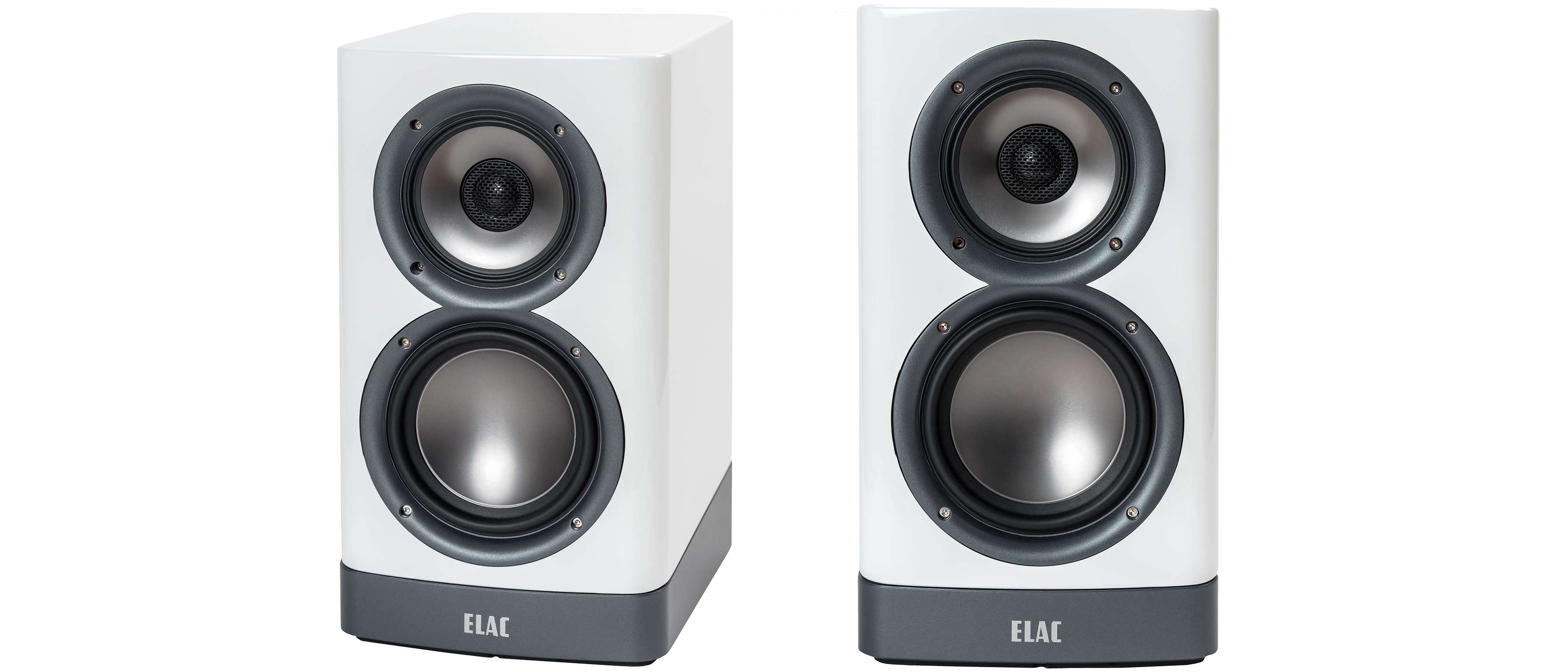Sound+Image Verdict
While the Navis ARB-51 from Elac do offer wireless audio, it's certainly not the front on which we'd recommend them. Their cabled performance, on the other hand, is stellar, with the entirely analogue signal path producing wonderful musicality and top-notch tweakable performance.
Pros
- +
Huge musical performance...
- +
...through the active analogue path
- +
Driver-level tweaks
Cons
- -
Wireless delivery less thrilling
Why you can trust What Hi-Fi?
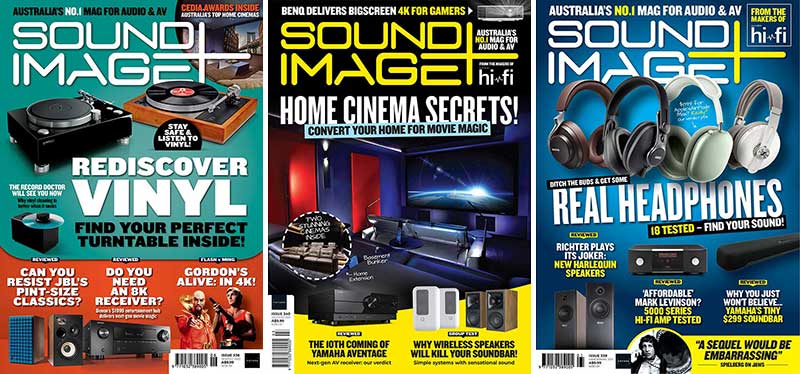
This review originally appeared in Sound+Image magazine, one of What Hi-Fi?’s Australian sister publications. Click here for more information on Sound+Image, including digital editions and details on how you can subscribe.
Where many wireless active speakers are all about receiving the signal
wirelessly so you can keep things exceedingly neat up front, ELAC has gone a different way. You could go wireless here, using one of ELAC’s transmitter boxes. But you may not thereby enjoy the very best these speakers have to offer. For that, you should give them an analogue input, either RCA unbalanced or XLR balanced.
Because their designer, the invariably impressive Andrew Jones, has kept those inputs entirely analogue, free from DSP right through the internal amplification and on to the drivers. In so doing, Jones has delivered a thoroughly pure and magnificent-sounding active speaker – which can work wirelessly, if you need it to.
Equipment
Germany’s ELAC is best known today for its hi-fi speakers, award-winning subwoofers and more. But the company’s earliest roots were actually in sonar, and in hi-fi’s golden years ELAC was known for its superb turntables and receivers, before getting more into speakers in the 1980s. In more recent years its electronics have been in resurgence again.
So it is well-placed now to combine its electronics and speaker expertise in an active speaker. The Navis concept is available in a floorstander, the ARF-51, but it is the standmount ARB-51 which is perhaps the more attractive proposition, an acceptable 35cm high, our review pair resplendent in a smooth white gloss which tapers away, physically and chromatically, to a dark grey base which at the rear takes the mains input for each speaker, nicely isolating the power section from the two aforementioned signal inputs above. Dedicated stands are available, the L80 model, priced at AU$695 the pair.
And unusually it’s a three-way standmounter, where the 25mm soft-dome tweeter is concentrically positioned in the centre of the midrange 102mm (four-inch) aluminium driver, with a 133mm aluminium bass cone below, with the crossover points at 2.2kHz and 260Hz. The positioning of the tweeter within the midrange aids imaging since those drivers present effectively a combined point source — Andrew Jones, of course, cut his teeth at KEF, where the same principle is harnessed in their Uni-Q technology.
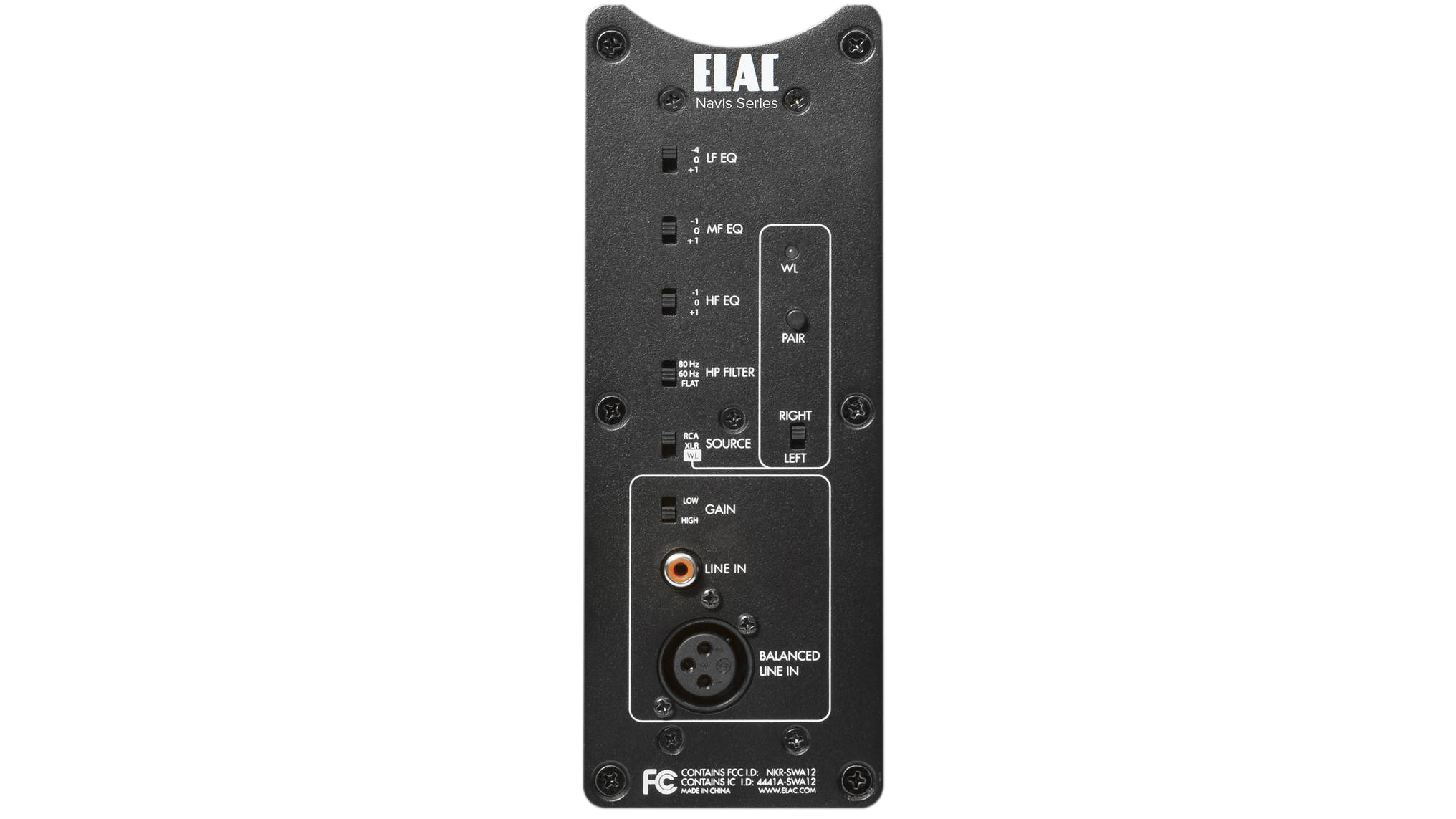
The Navis is rear-ported, and the strip below the port has not only the inputs but an initially bewildering array of little switches: seven in all, and for each speaker, since unlike many active speakers there is no ‘master’ and ‘slave’; the two are identical and you use the first of these switches to allocate left and right position for each speaker.
Another three-position switch selects between the RCA input, the XLR input, or the ‘AirX2’ wireless input. Three more three-position switches allow you to tailor the output of each driver 1dB up or down, and individually for each speaker; it’s a surprise that a designer of Andrew Jones’ confidence and experience (Celestion, KEF, Infinity, Pioneer and its high-end TAD brand) would let you mess with his preferred tuning, but it’s described mainly in terms of room correction.
The bass switch actually flips between +1dB, 0, or -4dB, the last position being in case you have to place the speakers closer to the room boundaries. Jones wisely suggests toeing them in to create a perfect triangle, to make the most of those coincident drivers.
The final switches are a gain selector on the inputs, and a high-pass filter switch to be used if you add a subwoofer to the system, with three options: flat, 60Hz or 80Hz.
Inside each speaker is a ‘Tri-Amp Pure Analog Amplifier’, essentially three separate amps, one for each driver: a 160W BASH AB amplifier for the woofer, a 100-watt BASH AB amplifier for the midrange, and a 40-watt Class-AB amplifier for the tweeter.
A BASH amplifier as we understand it is actually a Class-D circuit feeding rapidly-scalable pulsed power to a Class-AB amplifier (replacing the traditional power supply), thus removing the need for the output filter, yet keeping the efficiency high. Not only does this all mean a whacking 300W of power on tap for each channel, the combination delivers audiophile-level specs like 110dBA signal-to-noise ratio and a 100μV noise floor.
Listening
And we’ll say from the off that these were simply superb-sounding speakers, capable of a scale and room-filling ability you simply don’t expect from a standmount design, even a substantial one like the Navis. The inherent standmount advantages of control and precision were also present in abundance, with imaging a particular highlight. Yet they were also notably capable of controlled yet stomach-resonating bass.
They absolutely nailed Billie Eilish’s bad guy, which runs a deliberately muffled kick drum and bass for the first verse, against which her layered vocals stand out in three-dimensional relief; this track both sparkled and slammed under the combination here of pinpoint imaging from the ELAC’s concentric drivers plus the extension available from the bass driver.
It’s notable in the specs that the lower point of the frequency range quoted for the standmount Navis at 44Hz is just 1Hz above that quoted for the floorstanding version, which shares the same power and the same drivers, but trebling up on the bass units. Further, the envelope for the frequency response isn’t stated but we can attest to significant output in the roll-off below the 44Hz, with a sweep indicating content rising from the low 30s of hertz up to a little dip around 110Hz-120Hz, then outstanding flat to the top, which is quoted at a more-than-healthy 28kHz.
This impressive bass performance was again in evidence when we moved from Eilish’s dark electropop to the dreamy Musk from Melbourne’s Tash Sultana, in which the bass guitar groove dominating the opening segment was in solid focus from the top to its bottom E, microdetailed in the edginess of strings on its slides, and impeccably imaged, a true portrait of a bass guitar, and in scale far more the presentation we’d expect of a floorstander than a standmount. There’s a lot going on in this song once the groove opens up, but the ELACs took it all in their stride, keeping it both separated and together, even effectively lifting the left-channel processed trumpet above the mix into its own little acoustic. Mmm, nice.
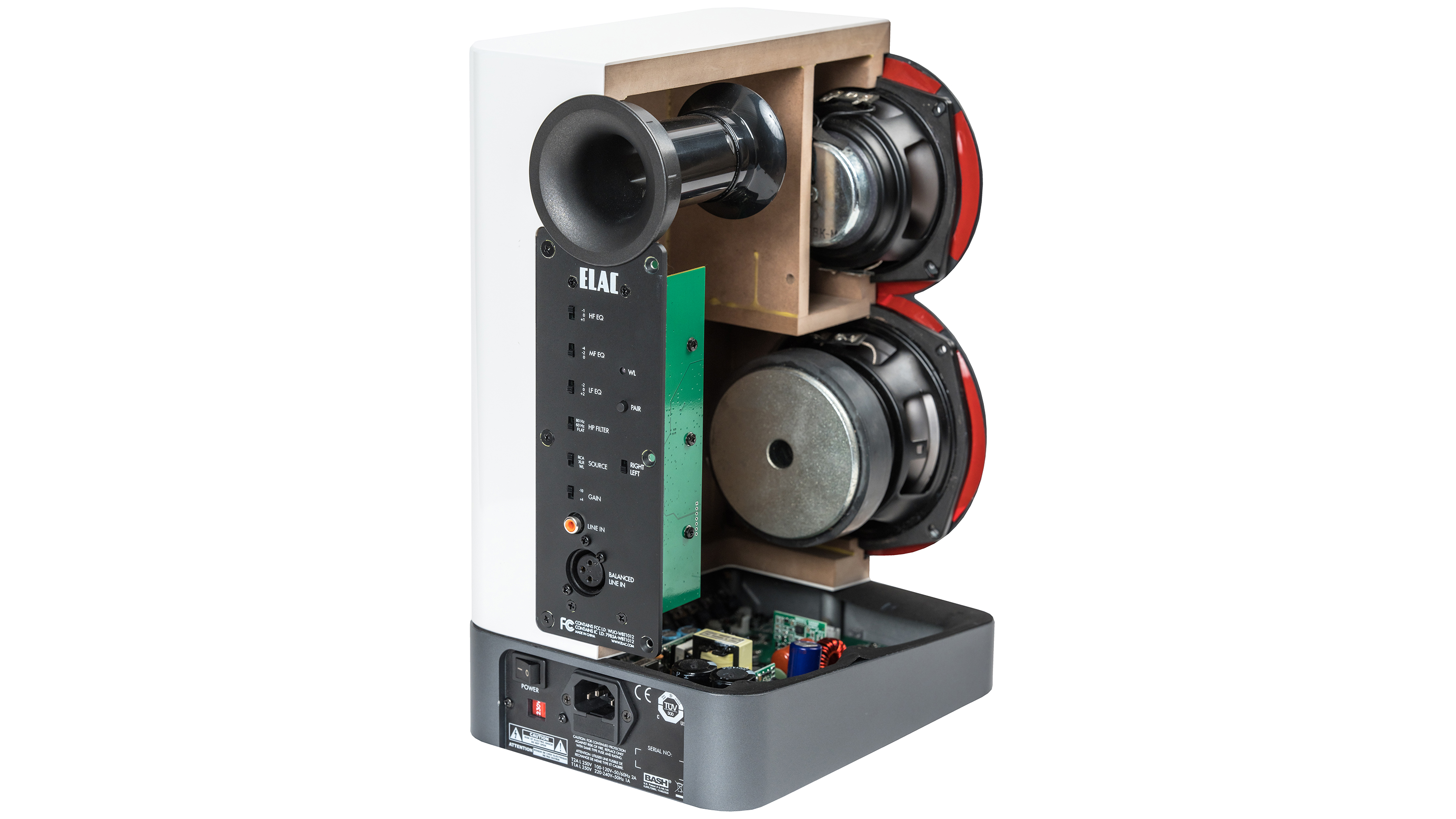
Moving along to classic rock, the ELACs resisted the temptation towards extravagance which the Stones themselves imparted to She’s A Rainbow and most of the rest of the ‘Satanic Majesties’ album from whence it came. The ELACs rather revelled in the ping-pong presentation – Mick left, harmonies right, band chugging along confidently in the centre until the madly compressed piano part takes its place for the orchestral break. It all emerged sounding just as it should – a cartoony presentation of a bunch of hippies trying a tad too hard to ‘do a Sgt Pepper’. And while there was a level at which some of the track’s edginess prevented us turning it up further, that was pretty darned loud.
And with better recordings, more purely made and mixed, such artificial volume restraints were removed. We enjoyed Ry Cooder and VM Bhatt’s Ganges Delta Blues, first in 320k AAC from Qobuz, then remembering we have our own 88.2k version, and playing that at a level which made the missus leave, but which was clearly free of distortion (the Water Lily Acoustics recording is exceptional) even playing at this level where the decay of Joachim Cooder’s dumbek was audibly running for a full three seconds behind the two masters’ duelling fretwork.
Roon, clever software that it is, shuffled straight into the Ry Cooder collaboration with Ali Farka Toure, ‘Talking Timbuktu’, and we’d so much forgotten how remarkable this recording is that we had to play it all the way through. Its soundstage was equally impressive through the ELACs and we were able to set levels to stun without the slightest hint of effort from either amps or drivers. (The missus had by this point left to do some gardening, and said she was enjoying it perfectly well from out there.)
Going wireless
All this listening was performed using the analogue inputs, specifically the XLR balanced inputs, running from a connected preamp. This provides the purest connection possible and, as noted, is fully analogue, free of the digital signal processing used in the vast majority of active speakers.
Then there is wireless operation, and with this comes an examination of the various ways you might choose to connect the ELACs to whatever sources you wish to play. We concluded that it’s far easier if you stick with a preamp and the analogue inputs – but ELAC’s AirX2 CD-quality wireless transmission does offer other options.
ELAC offers two boxes which can link to the Navis speakers. One is the Air-X2TW Wireless Transmitter, which retails at AU$295. This is simplicity itself – just a pair of RCA line-level inputs on a small box which then sends the signal wirelessly to the speakers. So you could send wirelessly (digitised to 16-bit/44.1kHz) from a preamp to the Navis’s wireless input. But as noted, you’d be far better to plug cables straight into the speakers unless you really can’t co-locate your hi-fi equipment, nor run cables between them.
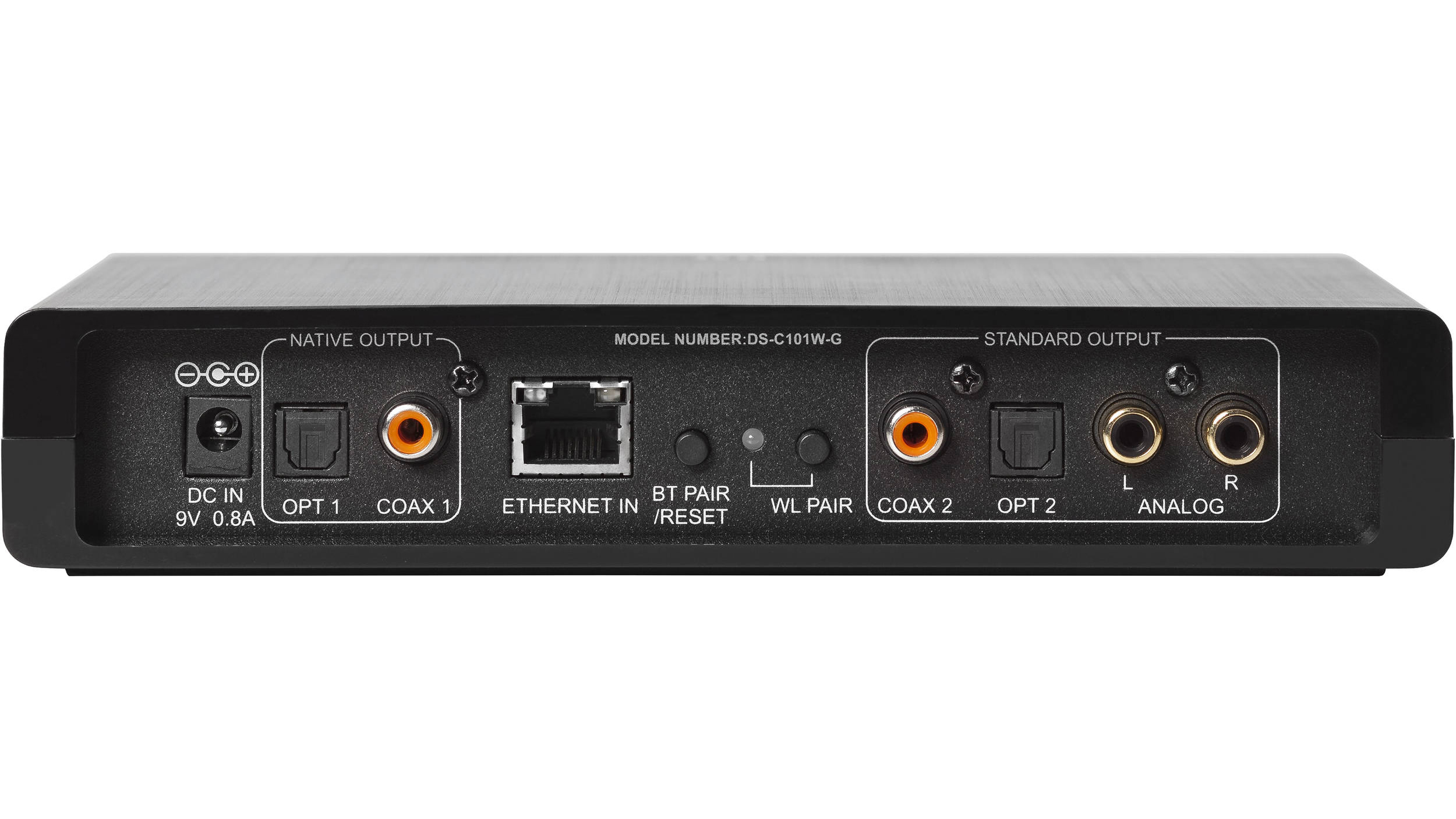
Second is the larger AU$699 Discovery Connect box (DS-C101W-G, pictured above), which requires some getting your head around. It delivers app-controlled operation of Spotify Connect, as well as AirPlay and Bluetooth and, increasingly useful, Roon Readiness. All these it can send via AirX2 to the Navis speakers.
We assumed it would also have inputs, into which we might plug sources, including perhaps optical from a TV or media player so the speakers could flank a TV, as is a common enough use for active speakers.
But while there are two sets of optical and coaxial sockets, plus one pair of analogue sockets, none of these are inputs. They are all outputs – two sets, in fact, capable of either native or downressed digital output, and only relevant if you’re plugging the box into a different amplifier entirely, or decide to plug the analogue outputs direct into the speakers.
So the Discovery Connect box doesn’t allow any additional device to be wirelessly connected to the speakers, in the manner of most such boxes (for example, the DALI and Q Acoustics speakers here). We never did find an easy way to play TV audio through the Navises.
Clearly, for analogue input into the Navises, you need a preamplifier with a volume control, and balanced outputs if you can get ’em. So we reckon for streaming you’d be better off having a separate streamer plugged into the preamp, or a preamp which has streaming built in. For a while we used the Cambridge Audio DACmagic 200 M as a preamp, its balanced outputs switched to variable so we could use its volume knob.
Then as chance would have it, Naim’s Uniti Atom HE arrived – a streaming preamp with balanced outputs, an optical input for our TV, analogue inputs for our turntable – a perfect companion here. And wow, that was one compact, smart, full-on hi-fi system to die for. Not cheap, to add the AU$4999 Naim preamp, but a brilliant solution in every way, from analogue turntable playback to Roon streaming.
Having said that, we did set up the Discovery Connect to play via AirX2 into the wireless input of the Navises, which requires pairing each speaker with the DS-C101, then addressing that unit from Spotify, and we had good music flowing very quickly. The bit-rate is limited to 16-bit/44.1kHz, and switching from analogue to wireless inputs requires fiddling round the back of both speakers to switch the little switches.
This is exacerbated by the speakers having no remote control, either to switch sources in this way or to control volume – because the Navises assume they’ll be under a preamplifier’s control. So when streaming from the Discovery Connect we were limited to control from our smart device, including the underwhelming app which is supposed to be called “the Discovery Connect App” but which we finally found in the Australian Apple store under the more prosaic listing of “DS-C101”.
Unfortunately, halfway through the first wirelessly-sent song, the right speaker faded then went off. We switched to AirPlay from an iPad Pro, and still only the left channel played. After rebooting everything, we couldn’t get them to pair at all. So we had little time in which to judge AirX2 streaming sonically.
But you know what? We’d say don’t bother with the wireless side of the ELACs at all. Give them analogue inputs direct from a good preamp, and let them play at their best.
Final verdict
The Elac Navis ARB-51 is a very different active speaker. For one thing, you need a preamplifier into which to plug your sources. And until ELAC releases a wireless box with inputs, we’d say stick to the cables here. Connect to the analogue inputs, connecting sources and streaming to your upstream preamplifier. Because these are absolutely terrific analogue active standmount speakers.

Jez is the Editor of Sound+Image magazine, having inhabited that role since 2006, more or less a lustrum after departing his UK homeland to adopt an additional nationality under the more favourable climes and skies of Australia. Prior to his desertion he was Editor of the UK's Stuff magazine, and before that Editor of What Hi-Fi? magazine, and before that of the erstwhile Audiophile magazine and of Electronics Today International. He makes music as well as enjoying it, is alarmingly wedded to the notion that Led Zeppelin remains the highest point of rock'n'roll yet attained, though remains willing to assess modern pretenders. He lives in a modest shack on Sydney's Northern Beaches with his Canadian wife Deanna, a rescue greyhound called Jewels, and an assortment of changing wildlife under care. If you're seeking his articles by clicking this profile, you'll see far more of them by switching to the Australian version of WHF.
